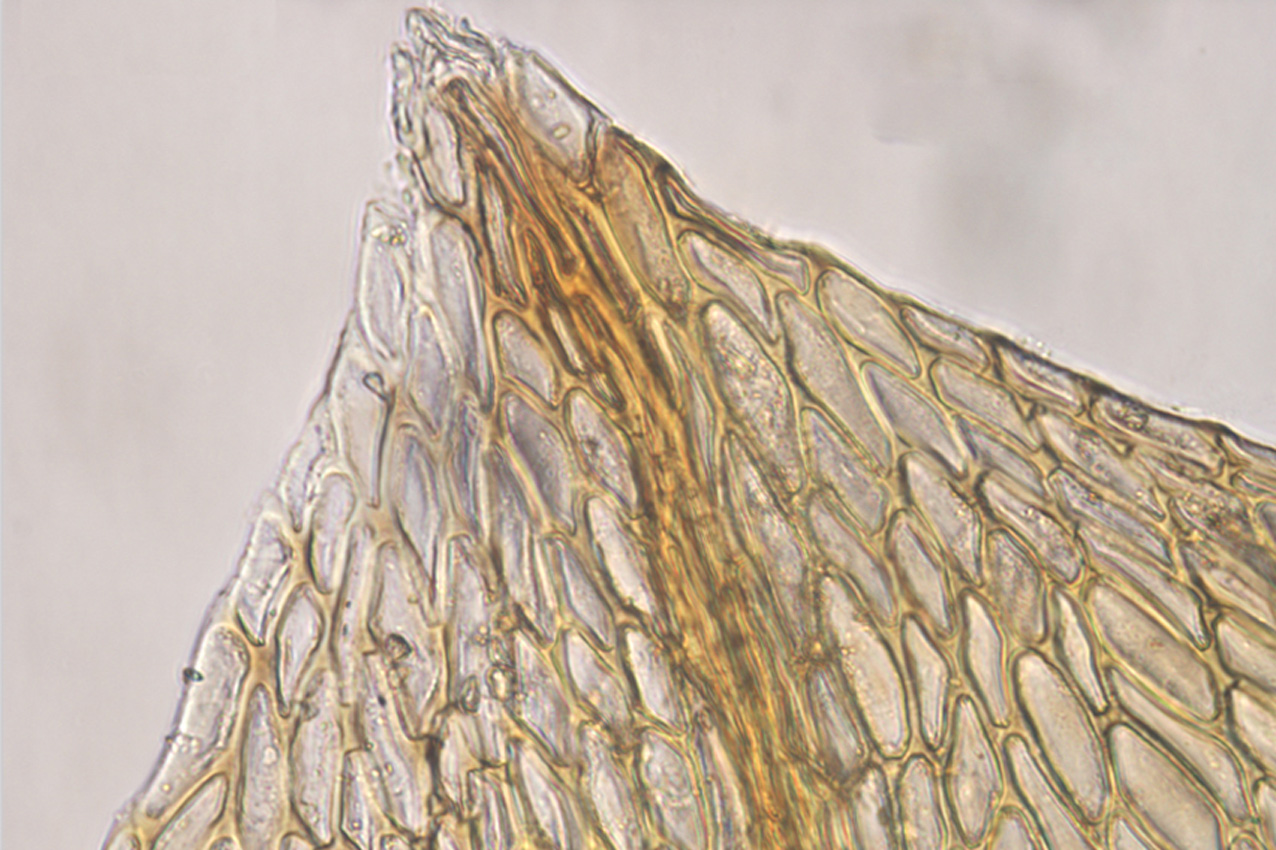Abstract
The form of the gemmae appears to be constant within Bryum species, and it is an important character for distinguishing among closely related species. In this study, we describe a new species of Bryum, B. glacierum Y.Y. Liu & Y.H. Wu, that was collected from Tianshan Mountain in China along with a description of its gemmae. This species is distinguished morphologically by (1) gemmiforfm to julaceous shoots; (2) broadly ovate leaves, strongly concave, with obtuse to acuminate apex, plane and undifferentiated leaf margins, rhombic to rhomboidal distal and medial cells; and (3) dark red-brown, obconic or ovate bulbils with peg-like leaf primordia, densely clustered in the leaf axils of sterile shoots. The new moss species is currently known from two localities in northwestern China. The species seems to prefer high altitudes, growing as a pioneer mainly on ground exposed by retreating glaciers. The principal distinctive characters that separate Bryum glacierum from similar species of Bryum and Pohlia are discussed. An identification key for bulbiferous species of Bryum in China is provided.
References
<p>Bruch, P., Schimper, W.P. & Gümbel, W.T. von (1846) <em>Bryologia Europaea</em> 4. E. Schweizerbart, Stuttgart, 163 pp.</p>
<p>Erzberger, P. & Schröder, W. (2013) The genus <em>Bryum</em> (Bryaceae, Musci) in Hungary. <em>Studia Botanica Hungarica</em> 44: 5–192.</p>
<p>Frey, W. & Stech M. (2009) Bryophytes and Seedless Vascular Plants. 3: I–IX.<em> In: </em>Frey, W., Stech, M. & Fischer, E. (Eds.) <em>Syllabus of Plant Families</em>—<em>Adolf Engler’s Syllabus der Pflanzenfamilies.</em> 13th ed. Gebruder Borntraeger Verlagsbuchhandlung, Berlin, pp. 1–263.</p>
<p>Hedwig, J. (1801) <em>Species Muscorum Frondosorum Descriptae</em>. Leipzig, pp. 118–187.</p>
<p>Höhnel, F. (1895) Beitrag zur Kenntniss der Laubmoosflora des Hochgebirgstheiles der Sierra Nevada in Spanien. <em>Sitzungsberichte der Kaiserlichen Akademie der Wissenschaften, Mathematisch-Naturwissenschaftlichen Classe, Abteilung</em> 1 104: 297–336.</p>
<p>Hornschuch, C.F. (1822) Flora 5. <em>Sylloge Plantarum Novarum</em> 1 (3): 62–64.</p>
<p>Köckinger, H., Holyoak, D.T. & Suanjak, M. (2013) <em>Bryum austriacum</em> Köckinger, Holyoak & Suanjak, a new bulbiliferous species from the Alps (Bryaceae, Bryopsida). <em>Journal of Bryology</em> 35 (1): 57–61. https://doi.org/10.1179/1743282012Y.0000000039</p>
<p>Koponen, T. & Luo, J.S. (1986) <em>Pohlia hisae</em>, species nova (Musci, Bryaceae) from Wo-long Nature Reserve, Sichuan, China. <em>Hikobia</em> 9: 315–317.</p>
<p>Li, X.J. (2006) <em>Flora Bryophytorum Sinicorum. </em>Vol. 4. Science Press, Beijing, pp. 1–111.</p>
<p>Liu, Y.Y., Wang, X.R. & Zhao, J.C. (2018) Propaguliferous species of <em>Pohlia</em> (Mielichhoferiaceae) in China, including two new records for China. <em>Bryophyte Diversity and Evolution</em> 40 (2): 18–36. https://doi.org/10.11646/bde.40.2.2</p>
<p>Liu, Y.Y., Zhao, J.C., Niu, Y.L. & Wang, X.R. (2020) Taxonomic summary of Bryaceae (Bryophyta) in China. <em>Chenia</em> 14: 45–57 .</p>
<p>Newton, A.E., & Mishler, B.D. (1994) The evolutionary significance of asexual reproduction in mosses. <em>Journal of the Hattori Botanical Laboratory </em>76: 127–145.</p>
<p>Schimper, W.P. (1860) <em>Synopsis Muscorum Europaeorum</em> cxxxviii. Schweizerbart, Stuttgardt, pp. 382–383.</p>
<p>Schwägrichen, C.F. (1811) <em>Species Muscorum Frondosorum, Supplementum Primum</em> 1. Barth, Leipzig, 136 pp.</p>
<p>Schwägrichen, C.F. (1816) <em>Species Muscorum Frondosorum, Supplementum Primum</em> 2. Barth, Leipzig, 89 pp.</p>
<p>Shaw, A.J. (1981) The taxonomy of <em>Bryum oblongum</em> and <em>B. blindii</em>. <em>Canadian Journal of Botany</em> 59: 1426–1435. https://doi.org/10.1139/b81-195</p>
<p>Shaw, A.J. (2014) The impact of molecular data on our understanding of the bryophyte flora of North America.<em> In: </em>Flora of North America Editorial Committee (Eds.) <em>Flora of North America</em> Vol. 28. <em>Bryophyta</em> Part 2. Oxford University Press, New York, pp. 3–13.</p>
<p>Smith, A.J.E. (2004) <em>The Moss Flora of Britain and Ireland</em>. 2nd ed. Cambridge University Press, Cambridge, pp. 528–636. https://doi.org/10.1017/CBO9780511541858</p>
<p>Spence, J.R. (1986)<em> Bryum calobryoides</em>, a new species from western North America. <em>The Bryologist</em> 89 (3): 215–218. https://doi.org/10.2307/3243287</p>
<p>Spence, J.R. (1987) A proposed reclassification of <em>Bryum</em>, <em>Anomobryum</em>, and <em>Brachymenium </em>(Musci, Bryaceae). <em>Journal of Bryology </em>14: 659–676. https://doi.org/10.1179/jbr.1987.14.4.659</p>
<p>Spence, J.R. (1988) <em>Bryum</em> Hedw. (Bryaceae) in western North America. <em>The Bryologist</em> 91 (2): 73–85. https://doi.org/10.2307/3242619</p>
<p>Spence, J.R. (1996) <em>Rosulabryum </em>genus novum. <em>The Bryologist</em> 99 (2): 221–225. https://doi.org/10.2307/3244553</p>
<p>Spence, J.R. (2005) New genera and combinations in the Bryaceae (Bryales, Musci) for North America. <em>Phytologia</em> 87: 15–28. https://doi.org/10.5962/bhl.part.4029</p>
<p>Spence, J.R. (2007) New combinations in the Bryaceae (Bryophyta) for North America. II. <em>Phytologia</em> 89: 110–114. https://doi.org/10.5962/bhl.part.24163</p>
<p>Spence, J.R. (2014a) <em>A Guide to Identification of Bryaceae with an Emphasis on North American Species</em>, Author’s technical report, 1–29. Available from: https://www.researchgate.net/publication/268278609 (accessed 2020 Dec. 1)</p>
<p>Spence, J.R. (2014b). Bryaceae.<em> In: </em>Flora North America Editorial Committee (Eds.) <em>Flora of North America</em> Vol. 28: <em>Bryophyta: Mosses</em> part 2. Oxford University Press, New York, pp. 117–185.</p>
<p>Spence, J.R. & Kellman, K.M. (2015) New and interesting species of <em>Gemmabryum</em> J.R. Spence & H.P. Ramsay (Bryaceae, Bryopsida) from California and the West. <em>Madroño</em> 62 (2): 124–135. https://doi.org/10.3120/0024-9637-62.2.124</p>
<p>Spence, J.R. & Ramsay, H.P. (2002) The genus <em>Anomobryum</em> Schimp. (Bryopsida, Bryaceae) in Australia. <em>Telopea</em> 9: 777–792. https://doi.org/10.7751/telopea20024017</p>
<p>Spence, J.R. & Ramsay, H.P. (2005) New genera and combinations in the Bryaceae (Bryales, Musci) for Australia. <em>Phytologia</em> 87: 61–72. https://doi.org/10.5962/bhl.part.4029</p>
<p>Sullivant, W.S. (1856) Report of exploration and surveys; description of the mosses and liverworts. <em>Report to the 33rd Congress</em>, Washington D.C., 4: 184–193.</p>
<p>Vanderpoorten, A. & Zartman, C.E. (2002) The <em>Bryum bicolor</em> complex in North America. <em>The Bryologist</em> 105 (1): 128–139. https://doi.org/10.1639/0007-2745(2002)105[0128:TBBCIN]2.0.CO;2</p>
<p>Wilczek, R. & Demaret, F. (1976) Les espèces du “complexe <em>Bryum bicolor</em>” (Musci). <em>Bulletin du Jardin Botanique National de Belgique</em> 46: 511–541. https://doi.org/10.2307/3667731</p>
<p>Zolotov, V.I. (2000) The genus <em>Bryum</em> (Bryaceae, Musci) in middle European Russia. <em>Arctoa</em> 9: 155–232. https://doi.org/10.15298/arctoa.09.19</p>


